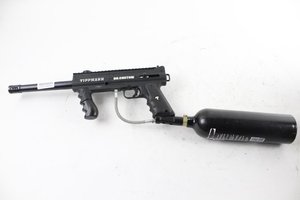- Joined
- Dec 2, 2005
- Messages
- 8,998
- Likes
- 5,475
With the shortage of ammo, I'm wondering of you can build a gas powered pneumatic rifle with as much
kinetic energy as a .223 cartridge.
You need very high pressure to replicate the gas pressure in an ignited cartridge. There's a technique used in DC-DC converters
where you make a charge pump to multiple the voltage by charging a bunch of capacitors in parallel then connecting them in series.
There's a technique they use for high voltage generators which is similar , but doesn't need any solid state switching, the Cockcroft-Walton generator

 en.wikipedia.org
It charges a bunch of capacitors in parallel until they reach the breakdow voltage of air, and then suddenly they're in series.
en.wikipedia.org
It charges a bunch of capacitors in parallel until they reach the breakdow voltage of air, and then suddenly they're in series.
I'm wondering if you could do the same thing with a manifold of little tanks ; you 'charge' all of them in parallel from a common
manifold from a CO2 gas cartridge, and then they have relief valves internally which connect them in series; when the pressure builds high enough, the valves
open and they are suddenly all in series, and you get a high multiple of the pressure.
If you need 55,000 psi, say, and you have a CO2 tank with 1000 psi, if you had 55 of these little micro chambers in parallel/series, could
you fire a .223 projectile with same energy as using gunpowder?
So with essentially a paintball CO2 tank, you could build a rifle that only needed projectiles, no cartridges or primers or powder. I guess question is how much volume of air is needed, so how big would the manifold array of 50 air chambers be?
It seems like they wouldn't have to be any larger than the case size of a .223 cartridge, and you 'd need 50 of them, maybe as holes drilled into
a sturdy block of aluminum?

kinetic energy as a .223 cartridge.
You need very high pressure to replicate the gas pressure in an ignited cartridge. There's a technique used in DC-DC converters
where you make a charge pump to multiple the voltage by charging a bunch of capacitors in parallel then connecting them in series.
There's a technique they use for high voltage generators which is similar , but doesn't need any solid state switching, the Cockcroft-Walton generator

Cockcroft–Walton generator - Wikipedia
I'm wondering if you could do the same thing with a manifold of little tanks ; you 'charge' all of them in parallel from a common
manifold from a CO2 gas cartridge, and then they have relief valves internally which connect them in series; when the pressure builds high enough, the valves
open and they are suddenly all in series, and you get a high multiple of the pressure.
If you need 55,000 psi, say, and you have a CO2 tank with 1000 psi, if you had 55 of these little micro chambers in parallel/series, could
you fire a .223 projectile with same energy as using gunpowder?
So with essentially a paintball CO2 tank, you could build a rifle that only needed projectiles, no cartridges or primers or powder. I guess question is how much volume of air is needed, so how big would the manifold array of 50 air chambers be?
It seems like they wouldn't have to be any larger than the case size of a .223 cartridge, and you 'd need 50 of them, maybe as holes drilled into
a sturdy block of aluminum?

Last edited:
